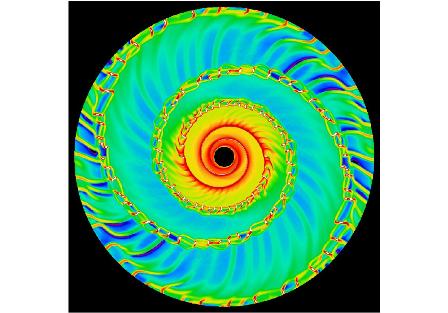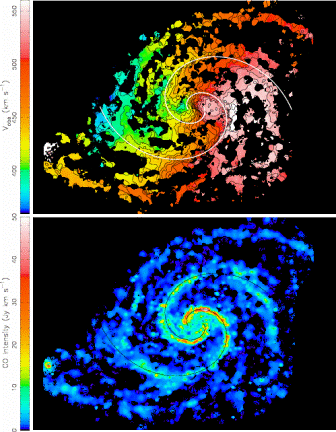 |
My research focuses on the process of star formation, the dynamics of the interstellar medium, and the structure and evolution of disk galaxies. My expertise is theoretical, and my research uses large-scale numerical hydrodynamics and MHD simulations as well as analytic models. Codes developed in my research group are used for simulating astrophysical systems that are accessible primarily using millimeter radio arrays; processes we have studied range from dust settling in protostellar disks to the formation of giant molecular clouds (GMCs) and interarm spurs in spiral galaxies. I also work in close collaboration with faculty, postdocs, and students within the LMA in interpreting radio observations from astronomical systems. These studies focus on detailed analyses of structure and kinematics in comparison to self-consistent dynamical models. |
|
GMC and Spur Formation in Spiral Galaxies
|

|

|
Turbulence in Molecular Clouds
Giant molecular clouds (GMCs) are the sites of essentially all star formation, and the dynamical processes in these systems therefore holds the key to defining the properties of the stars that form. The complex structure of GMCs is largely shaped by the collisions of cold molecular streams of gas, with the amounts and spatial distributions of high-density gas determined by the multi-scale dynamics of supersonic, magnetized turbulence. The clustering properties of stars, the stellar IMF, and the overall rate of star formation are all believed to derive from the the turbulent properties of GMCs, but the nature of these relationships are only now being discovered. An very active area of research involves using numerical simulations to model turbulent molecular clouds, and comparing the results of these models to observations of structure and kinematics observed in millimeter lines (from molecular gas) and continuum (from dust). The work of my group was influential in establishing the importance of turbulence to GMC structure and evolution, and our current research continues to broaden and deepen understanding of both fundamental processes and observable consequences. |
|
Kinematics of Spiral Arm Streaming
|

|
Back to the LMA page

